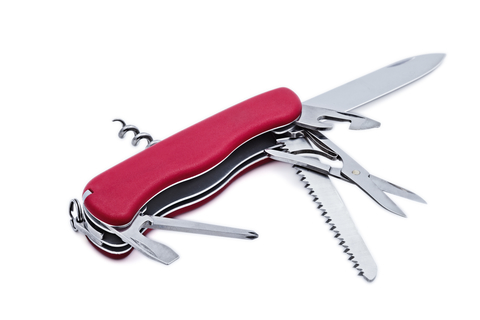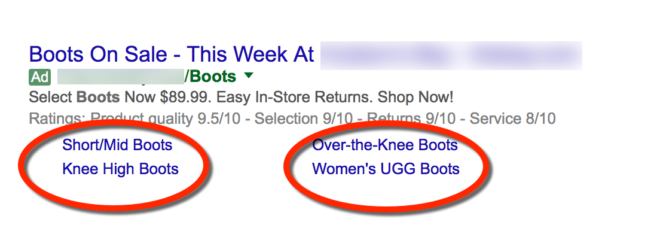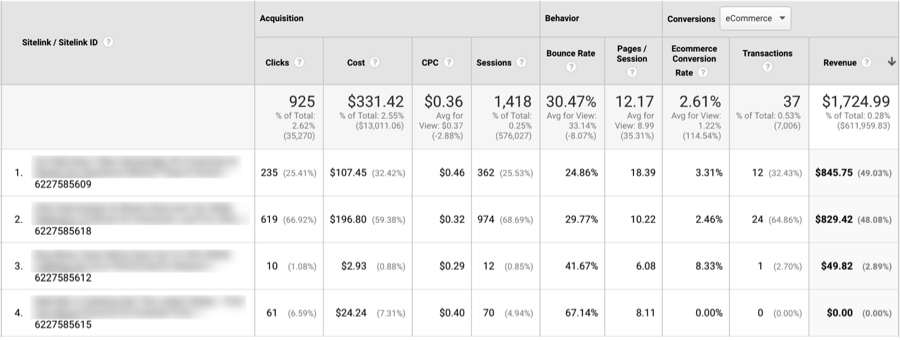Behold the marvelous Swiss Army knife! If you’ve ever owned one of these amazing tools, you know how incredibly handy they are. With its many attachments, it’s like having a toolbox in your pocket!
You’re unlikely to ever need a Swiss army knife when marketing your products to consumers. But you’ll be happy to hear there’s a similarly handy tool for solving B2C marketing problems: the ever adaptable sitelinks.
But before we get to the many MacGyver-type uses of sitelinks, let’s quickly review what they are.

Sitelinks 101
Sitelinks are a type of PPC ad extension. They appear as links below main ad text, displaying either as two columns or a single line (circled in red below):


As you can see, sitelinks are a way to add extra links to your ad, giving you more opportunities to leverage. It’s like having multiple ads in one.
The Many Different Ways to Use Sitelinks
As mentioned, sitelinks are like flexible tools that can be used to address many different B2C problems. Here are just a few:
1. Promote Low Search Volume Themes
It’s not unusual for clients to ask us to promote a new product or product line.
But how do you promote something so new that it’s not getting any search traction?
Fortunately, sitelinks provides a solution. Including the new product (or product line) as a sitelink within a related or branded ad is a simple way to garner exposure.
2. Push Lagging Products Out the Door
Sitelinks are also a great way to promote products with lagging sales. If you have a product that’s overstocked, or soon to be replaced by a newer version, you’ll want to get units out the door fast.
Again, sitelinks are a possible solution. By adding sitelinks to an ad with high volume keywords, you can harness some of that interest and direct it to slower moving products.
3. Maximize Hot Sellers
This isn’t to suggest that sitelinks are only useful in promoting slow selling items. In fact, they can be just as effective when used to give an additional push to top selling items.
4. Highlight Categories Within a Search Theme
Some product categories get lost within broader search themes because they’re too specific and/or have low search volumes. Again, sitelinks are a way to shine a light on these categories.
For example, if a client sells outdoor furniture (a popular search term) then we can use sitelinks to highlight sub-categories, such as loungers, club chairs and umbrellas.
5. Answer Common Questions
You can also use sitelinks to answer common questions.
Now you might resist the idea of paying for clicks that go through to information pages.
But in our experience, if people are looking for information about your company or product, they’re going to click on your ads anyway as part of their search. So why not make things easier by using a sitelink that takes them directly to the information they want?
Then, you can leverage this click by placing a call to action on the information page if desired.
6. Handle a PR Problem
Admittedly, we haven’t actually tried this ourselves, but it’s a strategy that makes sense in certain circumstances.
When PR issues emerge, people will often click on your ads in an effort to uncover the story. Rather than ignoring these clicks or suspending your campaign, why not use a sitelink to direct people to your company’s response? It’s a great way to get your version of events into the public sphere.
Here are a few more ideas for deploying sitelinks:

Landing Pages for Sitelinks
While we’re on the topic of sitelinks, it’s important to mention that you and your marketing team will need to put in place landing pages that can support these clicks. Because while the importance of ad landing pages are widely recognized, landing pages for sitelinks are sometimes overlooked.
Track How Sitelinks Are Performing
And speaking of sitelink clicks and landing pages, your marketing team is now able to see how sitelinks are performing post-click!
Google announced the launch of its new Google Analytics sitelinks report in April. This report includes data on sitelink clicks that lead to a website visit. So now you can see which sitelinks are performing as planned and which need to be omitted or adjusted.
Here’s an example of the type of data available to your team:

To learn more about this feature in Google Analytics, check out Pauline Jakober’s article in Search Engine Watch on the topic.
Do you love sitelinks as much as we do? How do you like to use them?






